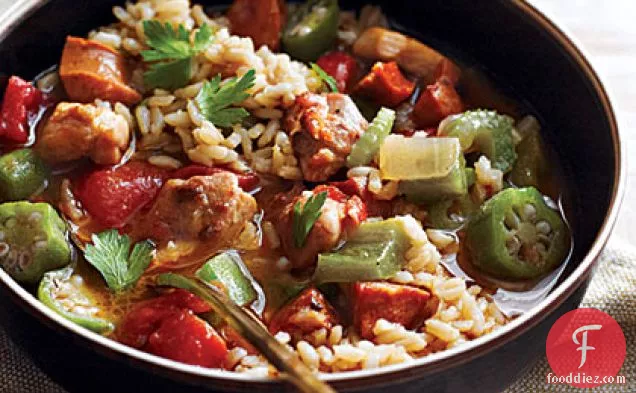Chicken and Sausage Gumbo

You can never have too many Creole recipes, so give Chicken and Sausage Gumbo a try. This main course has 678 calories, 26g of protein, and 23g of fat per serving. This recipe serves 6. If you have flour, salt, no-salt-added chicken stock, and a few other ingredients on hand, you can make it. To use up the flour you could follow this main course with the Apple Tart with Caramel Sauce as a dessert.
Instructions
2
Add sausage to pan; saut for 5 minutes, turning to brown on all sides.
Ingredients you will need![Sausage]() Sausage
Sausage
Equipment you will use![Frying Pan]() Frying Pan
Frying Pan
3
Remove sausage from pan using a slotted spoon, and drain on paper towels. Melt butter in drippings in pan.
Ingredients you will need![Sausage]() Sausage
Sausage![Butter]() Butter
Butter
Equipment you will use![Slotted Spoon]() Slotted Spoon
Slotted Spoon![Paper Towels]() Paper Towels
Paper Towels![Frying Pan]() Frying Pan
Frying Pan
4
Add oil to pan; swirl. Weigh or lightly spoon flour into a dry measuring cup; level with a knife. Stir flour into butter mixture; cook 3 minutes or until flour mixture starts to brown, stirring constantly with a whisk.
Ingredients you will need![Butter]() Butter
Butter![All Purpose Flour]() All Purpose Flour
All Purpose Flour![Cooking Oil]() Cooking Oil
Cooking Oil
Equipment you will use![Measuring Cup]() Measuring Cup
Measuring Cup![Knife]() Knife
Knife![Whisk]() Whisk
Whisk![Frying Pan]() Frying Pan
Frying Pan
6
Add onion and next 5 ingredients (through garlic) to pan; saut for 6 minutes or until vegetables are tender, stirring occasionally.
Ingredients you will need![Vegetable]() Vegetable
Vegetable![Garlic]() Garlic
Garlic![Onion]() Onion
Onion
Equipment you will use![Frying Pan]() Frying Pan
Frying Pan
Ingredients
170grams![andouille sausage, finely chopped]() andouille sausage, finely chopped710milliliters
andouille sausage, finely chopped710milliliters![bagged precooked brown rice]() bagged precooked brown rice2Tbsps
bagged precooked brown rice2Tbsps![butter]() butter1Tbsp
butter1Tbsp![salt-free Cajun/Creole seasoning]() salt-free Cajun/Creole seasoning411grams
salt-free Cajun/Creole seasoning411grams![no-salt-added whole tomatoes, drained and crushed]() no-salt-added whole tomatoes, drained and crushed2Tbsps
no-salt-added whole tomatoes, drained and crushed2Tbsps![canola oil]() canola oil118milliliters
canola oil118milliliters![thinly sliced celery]() thinly sliced celery710milliliters
thinly sliced celery710milliliters![no-salt-added chicken stock (such as Swanson)]() no-salt-added chicken stock (such as Swanson)79milliliters
no-salt-added chicken stock (such as Swanson)79milliliters![1.5 ounces all-purpose flour (about]() 1.5 ounces all-purpose flour (about5
1.5 ounces all-purpose flour (about5![garlic cloves, minced]() garlic cloves, minced177milliliters
garlic cloves, minced177milliliters![chopped green bell pepper (about 1 medium)]() chopped green bell pepper (about 1 medium)237milliliters
chopped green bell pepper (about 1 medium)237milliliters![frozen cut okra]() frozen cut okra237milliliters
frozen cut okra237milliliters![chopped onion]() chopped onion1teaspoons
chopped onion1teaspoons![salt]() salt227grams
salt227grams![skinless, boneless chicken thighs, cut into bite-sized pieces]() skinless, boneless chicken thighs, cut into bite-sized pieces
skinless, boneless chicken thighs, cut into bite-sized pieces
 andouille sausage, finely chopped710milliliters
andouille sausage, finely chopped710milliliters bagged precooked brown rice2Tbsps
bagged precooked brown rice2Tbsps butter1Tbsp
butter1Tbsp salt-free Cajun/Creole seasoning411grams
salt-free Cajun/Creole seasoning411grams no-salt-added whole tomatoes, drained and crushed2Tbsps
no-salt-added whole tomatoes, drained and crushed2Tbsps canola oil118milliliters
canola oil118milliliters thinly sliced celery710milliliters
thinly sliced celery710milliliters no-salt-added chicken stock (such as Swanson)79milliliters
no-salt-added chicken stock (such as Swanson)79milliliters 1.5 ounces all-purpose flour (about5
1.5 ounces all-purpose flour (about5 garlic cloves, minced177milliliters
garlic cloves, minced177milliliters chopped green bell pepper (about 1 medium)237milliliters
chopped green bell pepper (about 1 medium)237milliliters frozen cut okra237milliliters
frozen cut okra237milliliters chopped onion1teaspoons
chopped onion1teaspoons salt227grams
salt227grams skinless, boneless chicken thighs, cut into bite-sized pieces
skinless, boneless chicken thighs, cut into bite-sized piecesRecommended wine: Albarino, Rose Wine, Sauvignon Blanc
Albarino, rosé Wine, and Sauvignon Blanc are my top picks for Cajun. These low-tannin, lower alcohol wines will complement the heat in spicy cajun dishes, instead of making your mouth burn more. The Atlantis Albarino with a 4.9 out of 5 star rating seems like a good match. It costs about 14 dollars per bottle.

Atlantis Albarino
Elegant lemon-yellow color, clean and glossy. It is a very intense wine on the nose with persistent quality aromas, recalling green apple and tropical fruit, such as pineapple. On the palate, it is long and persistent with a perfect acidity that matches its body, making it a very pleasant wine full of sensations. This delightfully crisp and refreshing wine is hand harvested in small plastic boxes. The grapes are selected and pressed. Once the must is obtained, an alcoholic fermentation process begins, which is carried out in stainless-steel vats at a temperature of 64 degrees Fahrenheit. Following the fermentation period, a racking is performed to separate the lees; it subsequently undergoes a cold stabilization, it is filtered and then finally bottled.DifficultyHard
Ready In30 m.
Servings6
Health Score29
Related recipes
Turkey with Country Ham Stuffing
Party Italian Wedding Soup
Turkey Alfredo Tetrazzini
Stuffed Shells with Meat Sauce
Magazine

Your Inner Chef with Taylor Swift's Top 3 Recipes from Her Beloved NYC Hangout

20 Mouthwatering Recipes You Need to Try Today!

Master the Art of Making Perfect Pancakes with This Foolproof Recipe

The Science Behind Red Wine: Its Surprising Health Benefits and Potential Risks

12 Wine Cocktails for a Sophisticated Twist

Sip, Swirl, and Celebrate: Toasting to National Wine Day on May 25th

National Drink Wine Day on February 18

Celebrating Souffle Day with Delectable Delights

Indulge in the Delightful Flavor of Oyster Soup on Its Special Day!

Celebrating World Nutella Day

10 Tips for Healthier Cooking

Easy Latin American Recipes to Try at Home

How to Make the Perfect Birthday Cake

How to Debone a Chicken

How to Get Started with Healthy Cooking

12 Spring Vegetarian Recipes

15 Tasty Dessert Recipes

20 Best Breakfast Ideas to Enjoy this Spring

12 Healthy Spring Menu Ideas for 2022

Celebrate Spring with 3 Fresh Dishes

Your Inner Chef with Taylor Swift's Top 3 Recipes from Her Beloved NYC Hangout

20 Mouthwatering Recipes You Need to Try Today!

Sip, Swirl, and Celebrate: Toasting to National Wine Day on May 25th

National Drink Wine Day on February 18

Indulge in the Delightful Flavor of Oyster Soup on Its Special Day!

These Super Recipes for Your Football Party!

The Secrets Behind 3 Classic Comfort Food Recipes

Recipes to Spice Up Your February Menu

Top 20+ Must-Try Recipes Dominating February 2024







